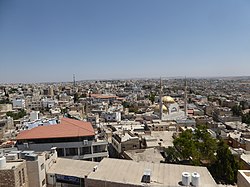Madaba
|
مأدبا Madaba |
||
|---|---|---|
|
|
||
| Coordinates | 31 ° 43 ′ N , 35 ° 48 ′ E | |
| Symbols | ||
|
||
| Basic data | ||
| Country | Jordan | |
| Madaba | ||
| ISO 3166-2 | JO-MD | |
| height | 763 m | |
| Residents | 70,338 (2004) | |
| politics | ||
| mayor | Arif Rawajeeh | |
Madaba ( Moabitic מהדבא, "water of calm"; Arabic مأدبا, DMG Maʾdabā ) is a city in Jordan with 70,338 inhabitants (2004 census). It is located around 35 kilometers south of Amman .
history
The city founded by the Moabites is mentioned several times in the Bible (including Num 21.30 EU , Jos 13.9-16 EU ). In the 1st century BC The city came under Nabataean rule , from 106 AD it was part of the Roman province of Arabia . In the 4th century the city was the seat of a bishopric, and in 614 it was conquered by the Persians . In 746 an earthquake destroyed the city, which was then abandoned and deserted by the residents. In 1880 it was repopulated by Christians, and old mosaics were found under the rubble. In 1897 there were still remnants of 10 churches, but they were already integrated into residential buildings.

Church of John the Baptist
The Roman Catholic Church, completed in 1913 (on the highest elevation of the town), stands on a crypt, some of which is more than 2000 years old, in which, among other things, a shrine with a sculpture depicting the head of John the Baptist , remains of ancient mosaics and a Moabite fountain. Corridors lead from here to other buildings.
St. George's Church
The Greek Orthodox Church contains the famous Madaba mosaic , which shows a map of Palestine from the 6th century.
City and Mosaic Museum
Museum with mosaics (partly in original locations) and other archaeological finds. There is also an ethnographic section.
education
Madaba is the seat of the American University of Madaba (AUM) and the new campus of the German-Jordanian University (GJU).
literature
- Frank Rainer Scheck: Jordan. Peoples and cultures between the Jordan and the Red Sea. DuMont, Ostfildern 2005, 5th ed. Pp. 251-261, ISBN 3-7701-3979-8
Web links
Individual evidence
- ^ Klaus Beyer: The language of the Moabite royal inscriptions. In: Small studies on the language of the Old Testament and its environment 11 (2010), pp. 5–41, here pp. 13f.
- ↑ 1967 recognized by Rome


